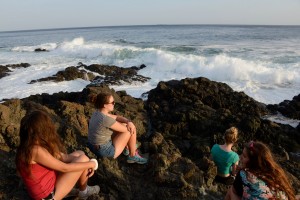 Hello World! This is Emma, Rayna and Naty and we’re here to give you the best blog post ever!
Hello World! This is Emma, Rayna and Naty and we’re here to give you the best blog post ever!
Tuesday afternoon, nine of us left Pedasí to stay at Achotines Research Facility, where tuna are studied in detail. Did you know that not much is known about tuna? Isn’t that crazy? Well, now we know, and now you know, too. We observed the feeding of the tuna in captivity, and learned about how the staff at Achotines works with the fish.
We also walked through the tropical dry forest surrounding their facilities. We saw howler monkeys, cacti, and, at nighttime, we took a walk to the Pacific Ocean. Did you know that we (all three of us!) have never seen the Pacific Ocean before this trip? Crazy, right?
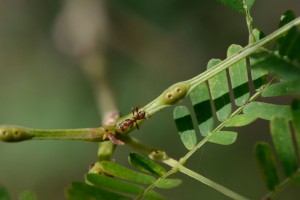 We saw a small tree species (Bull Horn Acacias) loaded with ants. The ants protect the tree from herbivores, and the Acacia houses the ants in the thorns. The Acacia provides food for the ants with little protein rich nobs at the end of new leaves, and provides nectar to the ants in nectaries at leaf bases. The ants also clear the ground around the trees, and that reduces competition for the tree! Crazy, right? We also discovered, that at night, if you look around with your headlamp on, spiders look like diamonds in the grass. I (Emma) was very excited to find my arachnid friends in the forest. Spiders are so cool, right?
We saw a small tree species (Bull Horn Acacias) loaded with ants. The ants protect the tree from herbivores, and the Acacia houses the ants in the thorns. The Acacia provides food for the ants with little protein rich nobs at the end of new leaves, and provides nectar to the ants in nectaries at leaf bases. The ants also clear the ground around the trees, and that reduces competition for the tree! Crazy, right? We also discovered, that at night, if you look around with your headlamp on, spiders look like diamonds in the grass. I (Emma) was very excited to find my arachnid friends in the forest. Spiders are so cool, right?
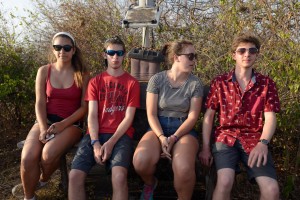 We spent twenty-four hours at Achotines, and when we got back to Pedasí at exactly 1:42 the next day, we had classes beginning at 2:00. The other half of the group left for Achotines when we arrived back at school. This morning, while half of our friends were hangin’ out with the tuna and gettin’ fishy, we went Azuero Earth Project, an organization that works to better our natural world!
We spent twenty-four hours at Achotines, and when we got back to Pedasí at exactly 1:42 the next day, we had classes beginning at 2:00. The other half of the group left for Achotines when we arrived back at school. This morning, while half of our friends were hangin’ out with the tuna and gettin’ fishy, we went Azuero Earth Project, an organization that works to better our natural world!
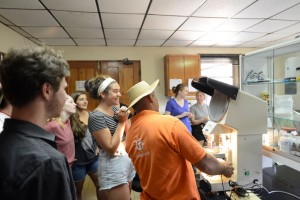 We helped cultivate the earth near the organization’s headquarters, and we learned about the process of creating mulch. Did you know that there is no Spanish word for “mulch”? Crazy, right? The entire experience was very enriching. We also got to have an amazing lunch after, with freshly picked basil and tomatoes, (courtesy of Emma and Naomi), and the rest of the meal was made with all natural ingredients. Crazy, right?
We helped cultivate the earth near the organization’s headquarters, and we learned about the process of creating mulch. Did you know that there is no Spanish word for “mulch”? Crazy, right? The entire experience was very enriching. We also got to have an amazing lunch after, with freshly picked basil and tomatoes, (courtesy of Emma and Naomi), and the rest of the meal was made with all natural ingredients. Crazy, right?
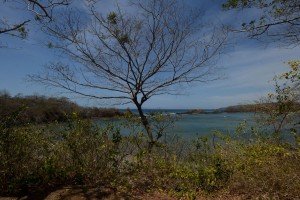 Since we are coming home in less than a week, we want to say thanks for keeping up with us, and while we’re sad to leave, we’re totally excited to come home and get cell phone service! And see all of your beautiful faces, of course. The memory of a snowless world will keep us company during this cold winter.
Since we are coming home in less than a week, we want to say thanks for keeping up with us, and while we’re sad to leave, we’re totally excited to come home and get cell phone service! And see all of your beautiful faces, of course. The memory of a snowless world will keep us company during this cold winter.
This is Emma, Rayna, and Naty signing out.
xoxo, Gossip Girl
————————————————
Achotines addendum: Both groups had a similar itinerary. First, there was a brief afternoon orientation to the field station (don’t scare the tuna, don’t let the dogs go on long walks with you, and enjoy the resources of the station site). We had free time in afternoon to avoid too much activity in the heat of early-mid afternoon At 5 pm we walked to, and then cliff-side along, the ocean to “el faro” (mini lighthouse). We discussed some some dry forest basics along the way. After dinner both groups went on a night hike through part of the forest and then to another ocean side site that has both beach and rocky shore. The light of the full moon caused us to pause both nights for a while as the surf pounded against the rocks. We got off to early (6:30 am) start the following day to be in the forest when as that’s when it is coolest and the animal life at it’s most active. After some discussion and journaling time, we returned in time for an 8:30 breakfast. Tuna feeding was at 10:30 am. The second group also got a tour of the lab facilities where we saw larval tuna, tuna eggs and rotifers that are reared to feed the larva tuna.
See Achotines photos at Photos 2015
-Steve
